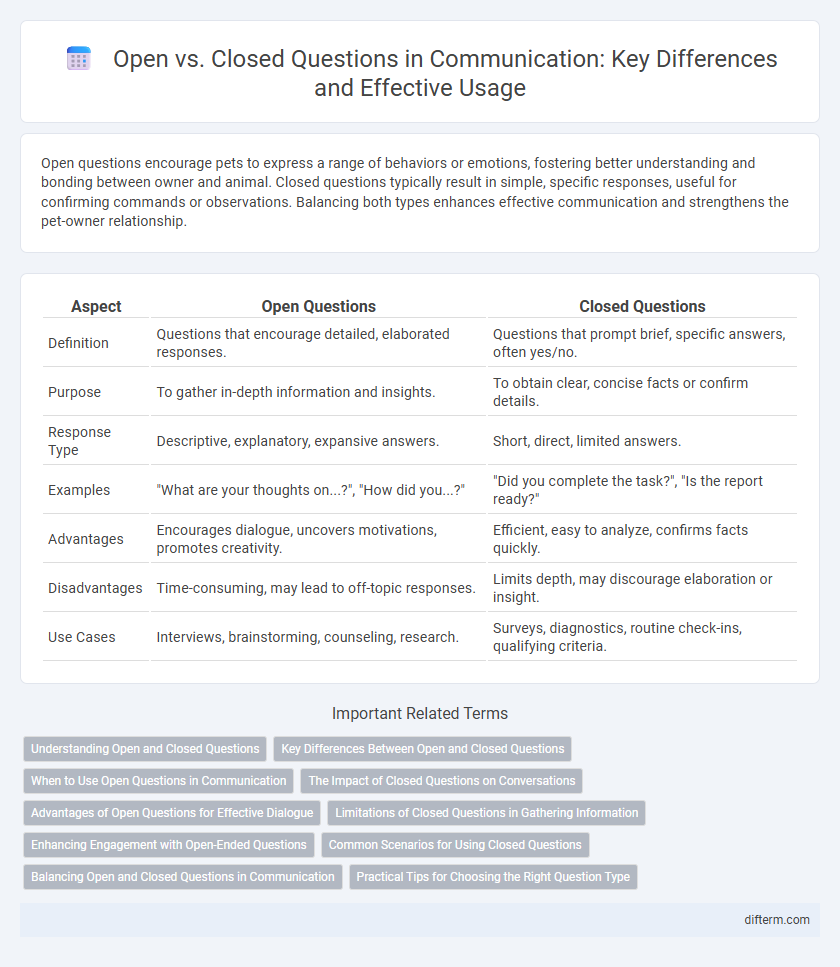Open questions encourage pets to express a range of behaviors or emotions, fostering better understanding and bonding between owner and animal. Closed questions typically result in simple, specific responses, useful for confirming commands or observations. Balancing both types enhances effective communication and strengthens the pet-owner relationship.
Table of Comparison
| Aspect | Open Questions | Closed Questions |
|---|---|---|
| Definition | Questions that encourage detailed, elaborated responses. | Questions that prompt brief, specific answers, often yes/no. |
| Purpose | To gather in-depth information and insights. | To obtain clear, concise facts or confirm details. |
| Response Type | Descriptive, explanatory, expansive answers. | Short, direct, limited answers. |
| Examples | "What are your thoughts on...?", "How did you...?" | "Did you complete the task?", "Is the report ready?" |
| Advantages | Encourages dialogue, uncovers motivations, promotes creativity. | Efficient, easy to analyze, confirms facts quickly. |
| Disadvantages | Time-consuming, may lead to off-topic responses. | Limits depth, may discourage elaboration or insight. |
| Use Cases | Interviews, brainstorming, counseling, research. | Surveys, diagnostics, routine check-ins, qualifying criteria. |
Understanding Open and Closed Questions
Open questions promote detailed responses by encouraging elaboration, fostering deeper understanding and engagement. Closed questions yield concise answers, often limited to yes/no or specific information, facilitating quick clarity and control in conversations. Balancing open and closed questions enhances effective communication by tailoring inquiry to context and desired depth of information.
Key Differences Between Open and Closed Questions
Open questions encourage expansive responses by inviting elaboration, fostering deeper understanding and richer communication. Closed questions elicit specific, concise answers, often limiting dialogue to yes/no or factual information. The key difference lies in open questions promoting exploration of thoughts and feelings, while closed questions facilitate quick, straightforward data collection.
When to Use Open Questions in Communication
Open questions are most effective when seeking detailed information, encouraging elaboration, and fostering meaningful dialogue. Use open questions in situations that require exploration of ideas, understanding emotions, or gaining insights beyond simple yes/no answers. They enhance active listening and build rapport by inviting respondents to share their thoughts freely.
The Impact of Closed Questions on Conversations
Closed questions, which typically require a short or one-word answer, can limit the depth and flow of conversations, reducing opportunities for elaboration and critical thinking. Their use often results in less engagement and hampers the development of rapport, as responders provide minimal information without exploring ideas further. In contrast, open questions encourage expansive dialogue, fostering better understanding and stronger interpersonal connections.
Advantages of Open Questions for Effective Dialogue
Open questions encourage detailed responses by inviting elaboration and deeper insight, fostering a richer exchange in communication. They promote active listening and empathy, enabling speakers to express thoughts and feelings freely, which strengthens mutual understanding. This approach enhances problem-solving and creativity by uncovering perspectives that closed questions often overlook.
Limitations of Closed Questions in Gathering Information
Closed questions restrict responses to predetermined options, limiting the depth and scope of information gathered. This constraint hampers the exploration of complex issues, reducing opportunities for detailed insights and nuanced understanding. Such limitations can result in incomplete data, affecting the quality of communication and decision-making processes.
Enhancing Engagement with Open-Ended Questions
Open-ended questions stimulate deeper conversations by encouraging detailed responses and critical thinking. These questions foster engagement, trust, and rapport in both personal and professional communication settings. Using open-ended inquiries increases active participation and uncovers richer information compared to closed questions that limit answers to yes or no.
Common Scenarios for Using Closed Questions
Closed questions are commonly used in customer service to obtain specific information quickly and efficiently. In medical consultations, they help clinicians narrow down symptoms by prompting concise, focused responses. Interviews also rely on closed questions to gather factual details and verify credentials.
Balancing Open and Closed Questions in Communication
Balancing open and closed questions enhances communication by encouraging both detailed responses and efficient information gathering. Open questions invite elaboration and deeper insight, fostering engagement and understanding, while closed questions provide clarity and quick verification. Effective communicators skillfully alternate between these question types to maintain dialogue flow and obtain comprehensive information.
Practical Tips for Choosing the Right Question Type
Open questions encourage detailed responses and foster deeper conversations by inviting elaboration and insight, making them ideal for brainstorming and relationship-building. Closed questions yield concise, specific answers, useful for gathering straightforward information or confirming facts quickly. Selecting the right question type depends on your communication goal--opt for open questions to explore ideas, and closed questions to obtain clear, definitive information efficiently.
open vs closed (questions) Infographic

 difterm.com
difterm.com